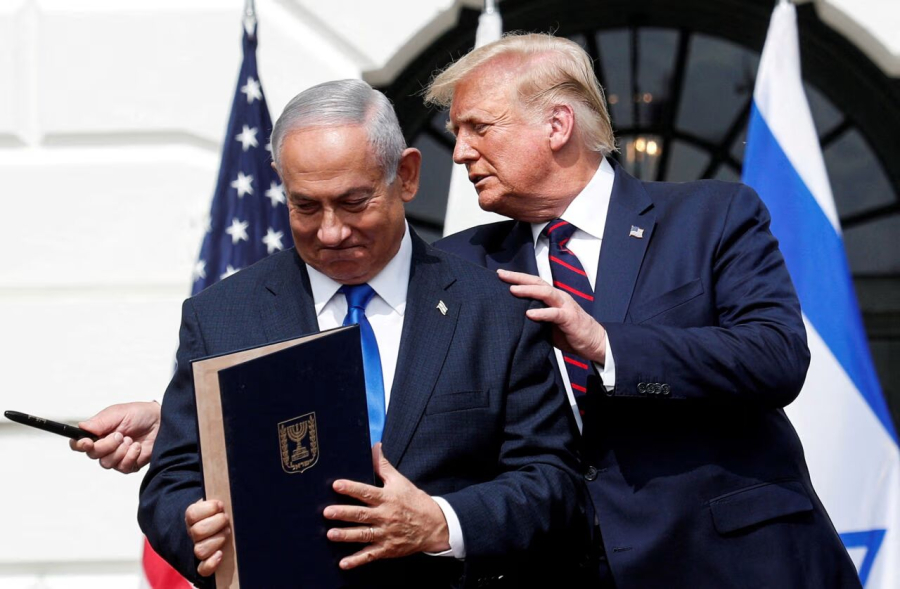By Ivan Kesic
Former Israeli military affairs minister Yoav Gallant’s letter to Leader of the Islamic Revolution Ayatollah Seyyed Ali Khamenei reads less like a victory lap and more like a plea for forgiveness.
Titled "Your Nuclear Dream Has Failed. Now You Must Choose," the letter was published on his Substack account and quickly amplified by Israeli media outlets and Western news agencies.
Gallant, who served as the regime’s war minister from 2022 until his dismissal in November 2024, had fallen out with Benjamin Netanyahu over policy disputes, particularly on the issue of the return of Israeli captives held in Gaza.
During his tenure, Gallant oversaw 14 months of devastating genocidal war on Gaza, which led the International Criminal Court in 2024 to issue arrest warrants for both him and Netanyahu on charges of war crimes and crimes against humanity.
Now under legal scrutiny and political exile, Gallant attempts to reframe his maligned legacy.
Yet his letter is laced with exaggerated claims recycled from Tel Aviv’s propaganda playbook during its failed military aggression against Iran, a campaign that not only failed to achieve its objectives but proved devastatingly counter-productive for the regime.
Boasts, threats, and a veiled ultimatum
In his open letter, Gallant painted an overly exaggerated – and at times fantastical – picture of Israel’s so-called military and intelligence supremacy over Iran.
“We see everything. We hear everything. We are everywhere,” he wrote, claiming that the Israeli regime has deep insight into Iran’s inner workings — including the Leader’s schedule, secure sites, communications, and even so-called “blind spots.”
He went as far as saying, “We knew more about you than you knew about yourselves.”
Gallant claimed that Iran’s so-called “Ring of Fire” strategy, built around Axis of Resistance allies like Hezbollah, Hamas, and other regional partners, had collapsed due to a coordinated Israeli-American military plot.
He also linked to Hamas’ October 7, 2023, historic operation, claiming that Iranian arms, training, and funding played a central role in the operation that changed regional dynamics.
The former military affairs minister also claimed that Israel had destroyed Iran’s air defenses, conducted overflights of Tehran as if it were Tel Aviv, assassinated senior Iranian commanders and nuclear scientists, and delayed Iran’s nuclear program by several years.
Toward the end of the letter, Gallant presented what he described as three stark choices: Attempt to rebuild the Axis of Resistance, a move he said would be swiftly dismantled. Accelerate nuclear development, which he warned would trigger even greater retaliation. Or negotiate, a path Gallant doubted Iran was prepared to take.
Likudnik delusions
Gallant’s open letter provides a glimpse into delusions held by the Israeli regime, particularly among its Likud leadership, about the realities on the ground across the region.
These delusions, echoed regularly by Netanyahu, paint a triumphalist narrative that stands in stark contrast to facts acknowledged even by Israeli analysts and opposition politicians.
The first and most glaring illusion is the claim of an Israeli "victory" over the Axis of Resistance. It is not only strategically premature but widely disputed by military and political observers.
Leader of the Islamic Revolution has often dismissed the idea that resistance has ended as a "totally wrong impression." In speeches late last year, he reminded audiences that “the spirit of Sayyed Hassan Nasrallah and Yahya al-Sinwar is alive, and their martyrdom did not take them out of the arena,” noting that “their souls, thought, and path shall continue.”
"Gaza is facing daily attacks and offering martyrs, but it is still resilient and resisting, and also Lebanon is resisting," Ayatollah Khamenei said in one of his speeches.
"Hezbollah is alive, thriving, and fulfilling its historic role. As always, the Islamic Republic will continue to support the mujahideen of Quds and those resisting the usurping criminal gang’s occupation of Palestine, God willing," he added.
And the events on the ground today – from Gaza to Tehran – corroborate his words.
Despite years of rhetoric from Netanyahu, who repeatedly declared “Hamas is dead,” the resistance in Gaza remains fierce. Recent incidents in Gaza have inflicted substantial losses on Israeli regime forces, and the resolve among Palestinians has only deepened under siege.
Similarly, after Israeli airstrikes assassinated senior Hezbollah leaders in 2024, Tel Aviv hoped the group would collapse or retreat. Instead, Hezbollah's capabilities remain largely intact. Its arsenal is safely housed in a vast network of underground bunkers, cleverly dispersed to avoid concentrated destruction and ensure survivability.
Gallant’s claim that Hezbollah is nothing more than “an Iranian strategic reserve” to be deployed at Tehran’s whim is part of a long-running myth that all regional resistance movements are mere Iranian proxies.
Hezbollah is first and foremost a Lebanese resistance movement, born out of the 1982 Israeli invasion of Lebanon, and its mission is primarily national: defending Lebanon from repeated Israeli aggression, as has been witnessed over the years.
During the recent war imposed on Iran, it didn’t need the intervention of its regional allies, including Hezbollah. Tehran defended itself directly using its own advanced missile and drone capabilities – a clear message that it can respond independently and decisively.
The claim that Sayyed Hassan Nasrallah “sought permission” to enter the war also fails the fact-check, contradicted by Hezbollah’s clearly stated goal: providing calibrated support to Palestinian resistance while avoiding wider escalation unless absolutely necessary.
Gallant’s portrayal of the so-called “Ring of Fire” – extending to Iraq, Yemen, and Syria – similarly distorts reality. Iraqi and Yemeni resistance factions remain active and engaged.
His reference to Syrian “realignment” is equally misplaced, as Damascus has not even played an operational role in the current situation. It has been totally out of the picture.
Fantasy of ‘victory’ over Iran
Gallant’s interpretation of the recent war imposed on Iran reads like a recycled press release from the failed Israeli psychological warfare campaign, a patchwork of tired propaganda, disinformation, and wishful thinking.
Among the most bizarre claims is the assertion that Israel achieved “air superiority” over Tehran. Iran was targeted by long-range air-to-surface missiles launched from American bases in Iraq, cruise missiles, sabotage drones, and covert explosions, not from manned aircraft piercing Iranian airspace, as the evidence reveals.
In one of the more theatrical deceptions, Israeli agents reportedly set tires ablaze near Tehran to simulate the aftermath of airstrikes, fabricating the illusion of stealth bomber attacks.
But the evidence on the ground tells a different story: limited structural damage consistent with small drone warheads, not the kind of devastation caused by bunker-busting bombs dropped from fighter jets.
Stealth jets may evade radar, but they do not evade the human ear. Their engines are thunderous, and yet over Iran’s densely populated cities, there were no reports of the roar associated with such aircraft, only the eerie whine of incoming cruise missiles or drones.
Iranian counterintelligence quickly dismantled the sabotage infrastructure that Israel had spent years constructing. Improvised drone workshops, clandestine operatives, and networks of informants were exposed and neutralized within days.
This rapid unraveling not only blunted the offensive but revealed the exaggerated nature of Israeli intelligence capabilities. Gallant’s narrative inflates these operations into a masterstroke when in reality, they were fleeting and largely ineffective.
Even more brazen is Gallant’s open celebration of the assassination of Iranian scientists, many of whom were not covert figures involved in secret military projects, but respected academics, public lecturers, and contributors to open scientific research.
Their addresses were no state secret. Their deaths were acts of terrorism, not tactical victories.
Gallant’s grandstanding closely mirrors the discredited claims made during the October 2024 campaign, when Israeli officials announced they had crippled Iran’s air defenses, missile production facilities, and nuclear infrastructure.
These claims were swiftly debunked by Iran’s successful retaliatory operations, which demonstrated both capability and strategic depth.
The June 2025 Israeli aggression failed across every strategic metric. It did not halt Iran’s nuclear or missile programs. It did not deliver a blow to Iran’s military leadership. It failed to erode popular support for the Iranian government, and most critically, it did not achieve its ultimate objective: the so-called “regime change.”
End of 47-year fantasy of ‘regime change’
The Israeli regime’s recent attempt to destabilize Iran through military aggression was never truly about military victory. It was about the 46-year project of “regime change”
The strikes against Iran’s scientific and military infrastructure were half-hearted at best, signaling that even Israeli planners were well aware of their own operational limits.
What they truly sought was psychological conquest – a collapse from within.
From the outset, this was a war of perception. The disinformation blitz about so-called Israeli “air superiority” and the fabricated claims of the elimination of Iran’s leadership were classic elements of psychological warfare. The aim was not battlefield dominance, but to instill doubt and fear among the Iranian people, to make them believe their government had failed them.
The war of aggression was mirrored by a carefully choreographed media campaign in the West, where pundits and analysts spoke of the imminent collapse of Iran. The glorification of the Pahlavi monarchy began resurfacing in mainstream outlets, painting it as a golden age.
But the streets of Iran remained silent and resilient. There were no uprisings. No collapse. No disintegration. Instead, the Israeli aggression had the opposite effect.
It galvanized the Iranian public. Much like the early 1980s during the Imposed War with Iraq, the nation united under war and siege. The people’s fury was not turned inward at their leaders, but outward at the regime dropping bombs on their cities.
This wasn’t just a tactical failure. It was the dramatic unraveling of a strategic ambition 46 years in the making. The plot hatched in Tel Aviv and Washington had fallen apart.
Since the 1979 Islamic Revolution, the American-Israeli axis has aggressively pursued regime change in Iran through sabotage, sanctions, covert operations, proxy wars, and media warfare.
The goal has always been clear: install a puppet regime that would dismantle Iran’s military, scientific, and economic sovereignty, and fold the country into the architecture of Western hegemony, just like it was before 1979.
Such a transformation would grant the US and Israel undisputed control over regional energy corridors, military balances, and strategic chokepoints, without a serious rival.
It would erase the Islamic Republic as a political model, a cultural pole, and a geopolitical obstacle and allow the Israeli regime to carry out its expansionism without any barriers.
From Menachem Begin and Ariel Sharon to Benjamin Netanyahu and Yoav Gallant, the torch of this “regime change” fantasy has been passed down through decades of Israeli leadership.
Figures like Yossi Cohen and Giora Eiland gave it shape through intelligence and diplomacy. But the fantasy has always crashed into the same wall: Iranian resilience.
The Islamic Republic has survived because of an enduring national will that has confounded even the most sophisticated operations, which was again on display during this war.
The so-called “opposition” remains fragmented, foreign-funded, and widely discredited. Military and intelligence options have failed repeatedly, and propaganda campaigns fall flat.
The 2025 aggression, with Gallant as its public face, may be the most overt and desperate iteration of the regime change strategy to date. Yet it ended with Gallant penning an open letter to Iran’s Leader, echoing a plea for negotiation.
The letter is a quiet admission of defeat and submission. His call for talks, wrapped in the language of threats, reveals the bitter truth: regime change has failed once again. And this time, the 46-year-old fantasy has been nipped in the bud.
Press TV’s website


















